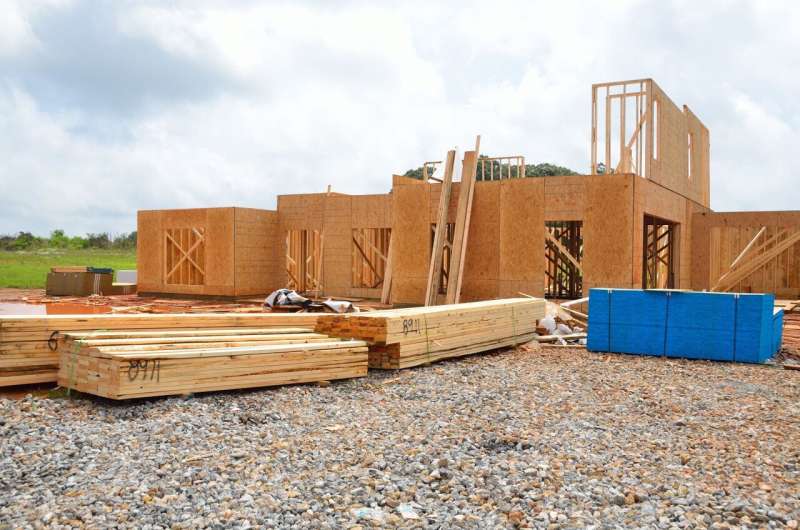This article has been reviewed according to Science X's editorial process and policies. Editors have highlighted the following attributes while ensuring the content's credibility:
fact-checked
peer-reviewed publication
trusted source
proofread
More with less: Researchers map a more sustainable path to home construction in Canada

Adopting the right mix of sustainable construction practices could allow Canada to meet its housing goals—as many as 5.8 million new homes by 2030—without blowing past its climate commitments.
Researchers in the University of Toronto's Centre for the Sustainable Built Environment (CSBE) have developed a computer simulation that forecasts the emissions associated with new housing and infrastructure construction. The paper is published in the journal Environmental Science & Technology.
The work builds on previous CSBE research showing that in order for Canada to meet its greenhouse gas emissions targets, homes built in 2030 will need to produce 83% fewer greenhouse gases during construction than those built in 2018.
"There is an obvious tension between our commitment to reducing our emissions and the need to restore housing affordability," says Shoshanna Saxe, an associate professor of civil and mineral engineering in the Faculty of Applied Science & Engineering who is the CSBE's director.
"But that tension only exists because of our status quo approaches to housing. As our research shows, we can build 5.8 million homes and cut GHG emissions from construction—it's just that we must build them differently than we have in the past."
In their latest paper, the CSBE team built what they call the future infrastructure growth (FIG) model, which enabled the team to evaluate the effect of implementing various strategies that aim to lower these emissions.
"We built our model using open data from the roughly 50,000 neighborhoods we currently have in Canada," says Keagan Rankin, a Ph.D. student who is first author of the new paper.
"We looked at aspects such as how many units there are per neighborhood, what type of housing stock comprises them, what length of road services them, etc. We then used what we know about current construction methods to model what the embodied emissions would be if you built a given number of new homes in the future, using the same distribution of neighborhood types.
"Once we had that, we were able to ask the question: How much could we reduce those emissions by adopting sustainable construction strategies, such as denser neighborhoods or better building design?"
The team looked at five strategies that could be implemented to reduce emissions associated with housing construction:
- Urban form: Analysis of existing neighborhoods showed that emissions per unit are lower for those that contain more multi-unit buildings (either high-rise or low-rise) than they are for those that consist mostly of suburban, single-family homes. This strategy would involve a shift toward more of these multi-unit neighborhood forms.
- Higher infill rate: This refers to placing new housing in existing neighborhoods—areas that are already built up. Because it reuses existing infrastructure, such as roads and water pipes, this new housing can be built with lower emissions than greenfield developments.
- Circularity: This strategy involves re-using existing buildings or infrastructure in the construction of new ones. For example, renovating a single-family home to become a multi-unit dwelling would require fewer materials than razing it and starting from scratch.
- Material technology improvements: Innovations in the way that materials such as concrete or steel are manufactured can reduce their carbon footprint. This strategy assumed that by 2030, our main construction materials will be produced with 20 to 25% fewer emissions than today.
- Best-in-class design: The team found that some housing designs were associated with lower emissions per unit, such as making the home smaller overall through better layouts. Another example involves the proportion of residential building that is underground. Since basements are typically made of carbon-intensive concrete, the same sized dwelling with a smaller basement would have lower emissions.
Multiple strategies will be required
Using the FIG model, the researchers showed that building housing at the rate required to restore affordability without any changes to construction practices would cause Canada to overshoot its climate commitments by 437%.
However, if the above strategies are implemented, the FIG model suggests that they would in fact be able to reduce emissions to below the target level.
The model also showed that while all five strategies are needed to reach the target, some of them had a stronger effect than others. For example, changing urban forms and using best-in-class design together accounted for roughly two-thirds of the improvements needed. By contrast, the strategies of infill, circularity and improvements in manufacturing each accounted for roughly one-tenth of the changes needed.
The researchers found that for the next one to two decades, the most important elements of sustainable building will be designing better buildings and building denser neighborhoods.
"The numbers are very close, and of course there's a certain amount of uncertainty associated with all of these estimates, but it was good to see that we came in below the line, because it means the situation is not completely hopeless," says Rankin. "There's no question that building 5.8 million homes by 2030 is an aggressive target. We may not get there, and if not, it would of course make it a bit easier to stay within our carbon budget.
"But we've done ambitious things as a country before, such as building a railroad from coast to coast in just five years. This analysis shows that the strategies we already know about are sound, and that all of them will be needed if we are going to prevent the worst impacts of climate change while also restoring housing affordability."
More information: Keagan H. Rankin et al, A Future Growth Model for Building More Housing and Infrastructure with Less Embodied Greenhouse Gas, Environmental Science & Technology (2024). DOI: 10.1021/acs.est.4c02070



















